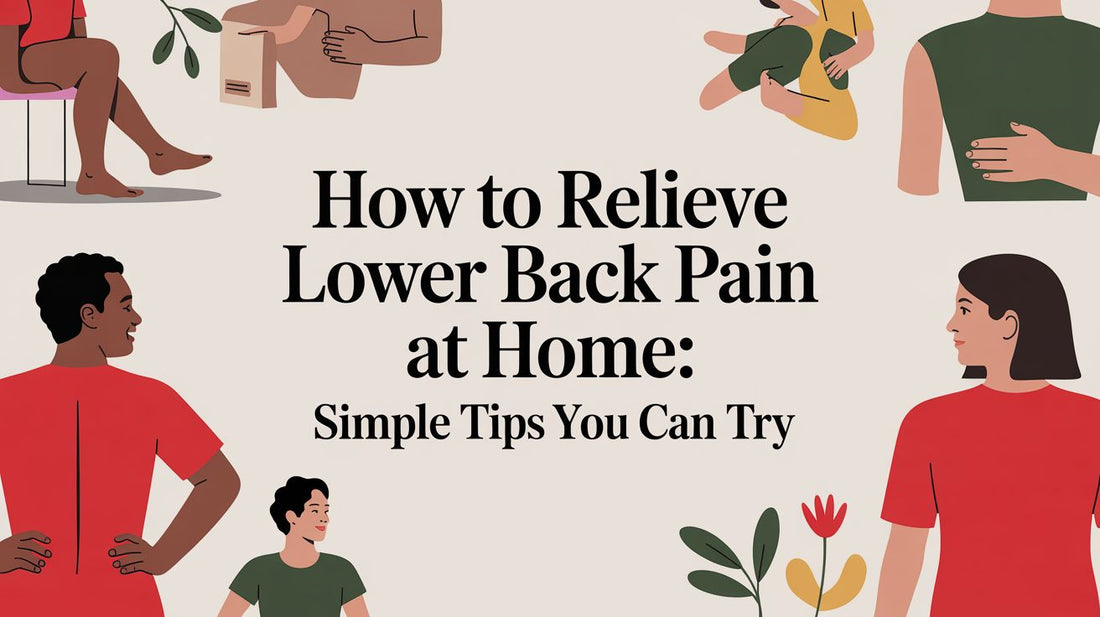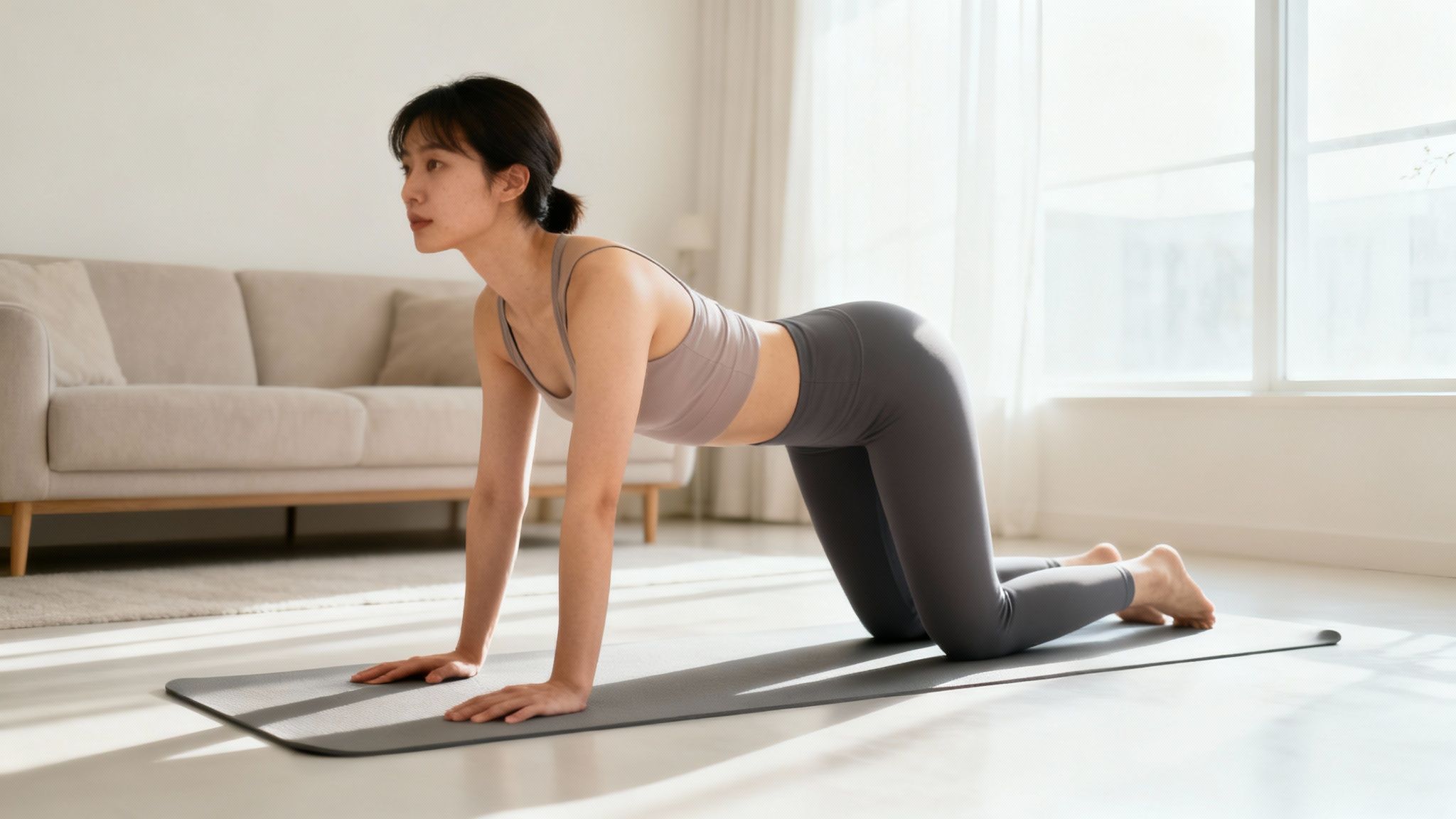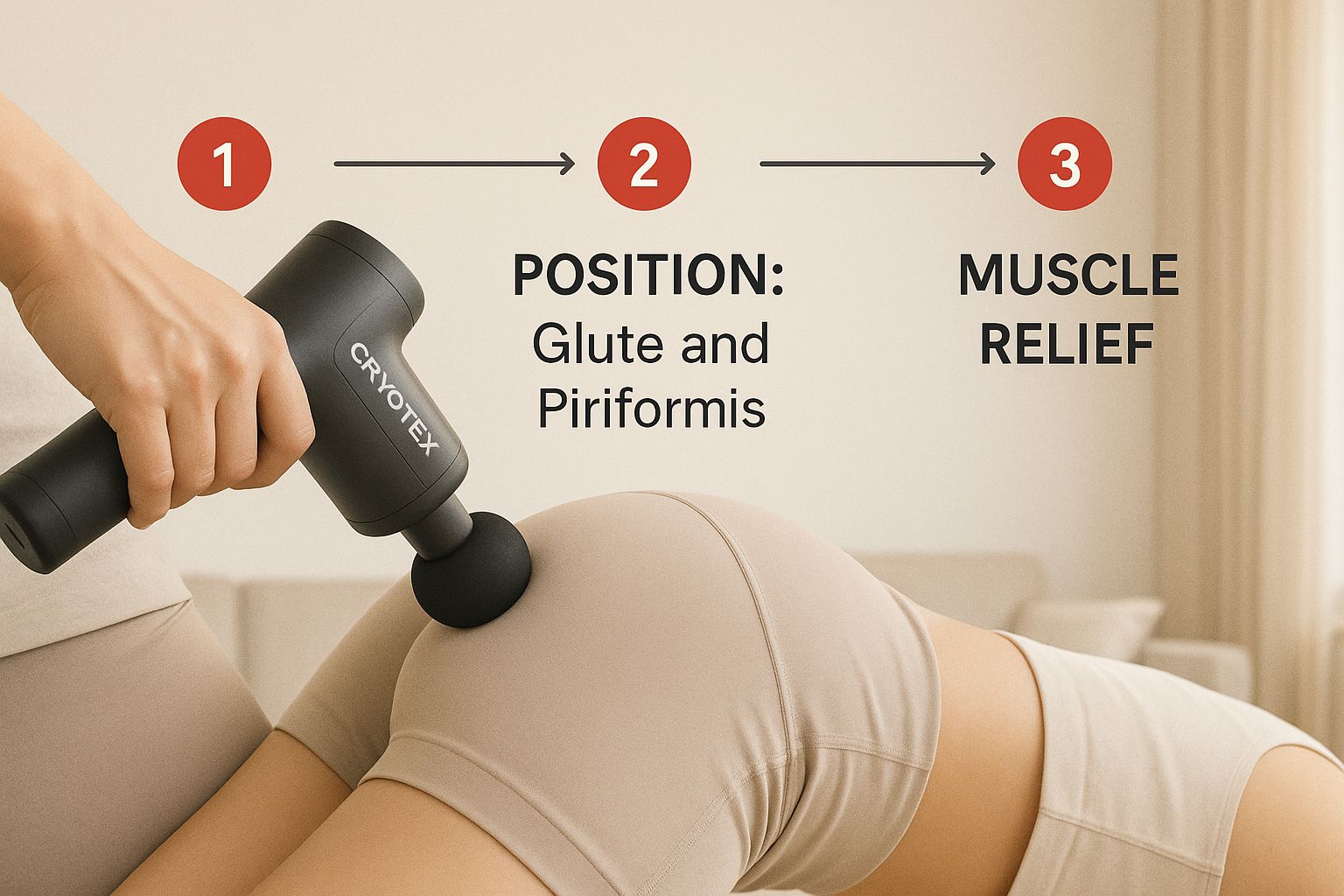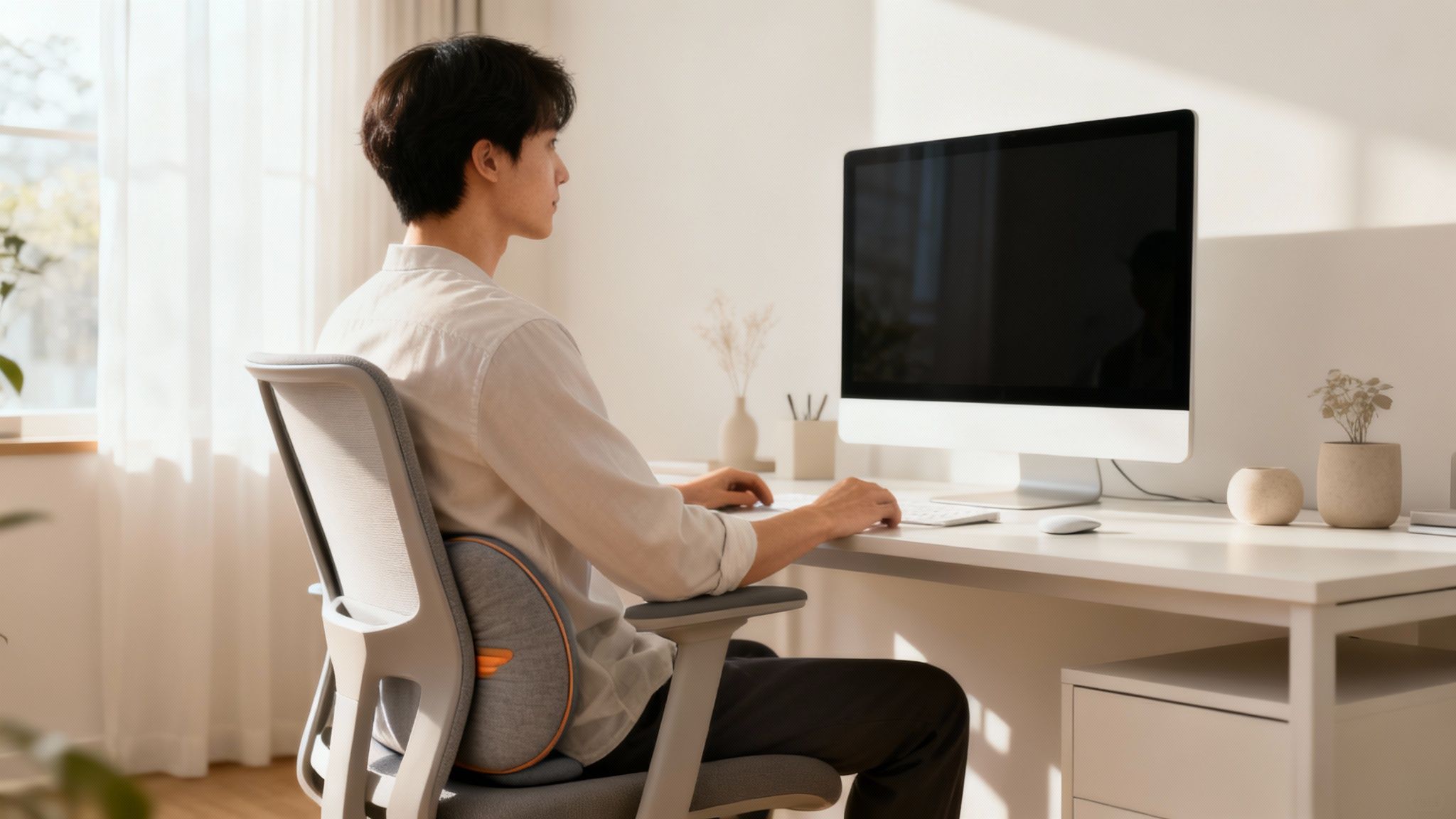
That nagging ache in your lower back doesn’t have to run your life. The good news? You have more power than you think to manage it right from home. It all comes down to combining gentle movement, smart daily habits, and targeted relief to find what works for you.
This guide is your playbook for learning how to relieve lower back pain at home using methods that are both safe and effective. These simple, actionable steps can help you feel better and get back to doing the things you love.
Your Practical Plan for At-Home Back Pain Relief
If you're dealing with lower back pain, you are far from alone. It's a massive global health issue, with estimates suggesting that as many as 619 million people worldwide felt it in 2020. For many, the discomfort isn't tied to a specific injury, which makes smart home-based care your first line of defense. You can find more insights on global back pain trends here.
This is why having a reliable plan matters so much. We're moving past generic advice to give you actionable steps you can fit into your daily life. We’ll explore how gentle movement, simple posture tweaks, and targeted tools like the Cryotex Massage Gun can work together to help reduce soreness and support a stronger, more resilient back.
"I sit at a desk all day, and my back was paying the price. Learning a few simple stretches and using the Cryotex on my glutes for a few minutes each evening has made a huge difference. It's that daily maintenance that keeps the serious aches away." — Jessica R., Chicago, IL
A Four-Part Strategy for Success
To get started, it helps to think of your approach in four key areas. Each one plays a unique role in managing discomfort and promoting recovery. We’ll dive deeper into all of these, but here's a quick look at the core game plan.
Quick-Start Guide to At-Home Back Pain Relief
Think of this table as your starting point for taking back control. By layering these techniques, you can build a personalized routine that addresses exactly what your back needs.
| Strategy | Primary Benefit | When to Use |
|---|---|---|
| Gentle Movement & Stretching | Helps improve flexibility and reduce muscle stiffness. | Daily, especially in the morning or after long periods of sitting. |
| Heat & Cold Therapy | Heat helps relax muscles; cold helps reduce temporary inflammation. | Cold for acute discomfort (first 48h); heat for chronic stiffness. |
| Ergonomic Adjustments | Helps reduce strain from daily activities like sitting or lifting. | Continuously at your desk, in your car, and while sleeping. |
| Targeted Massage | Helps release deep muscle knots and supports circulation. | As needed for targeted relief on sore muscles (avoiding the spine). |
This plan gives you the confidence to manage flare-ups and get back to doing what you love. For a deeper dive into the science, check out our complete guide on the benefits of percussive therapy.
Unlock Relief with Foundational Back Stretches
When your lower back feels tight, the last thing you probably want to do is move. But gentle, intentional movement is often the best way to help things feel right again. Think of it as hitting the reset button for all those tight, overworked muscles.

This isn’t about forcing yourself into a complicated yoga pose. It's about smart, simple movements that help restore flexibility and kick stiffness to the curb. A quick, consistent routine can be a game-changer, especially first thing in the morning or after a long day at a desk.
Stretches for Spinal Mobility and Lumbar Release
These movements are like a gentle conversation with your back. The golden rule? Always listen to your body and back off immediately if you feel any sharp pain.
Cat-Cow Stretch: This one is a classic for a reason. It gets the entire spine moving, helping to melt away tension.
- Get on your hands and knees, keeping your back flat like a tabletop.
- Inhale, letting your belly drop as you look up (Cow pose).
- Exhale, rounding your spine up toward the ceiling and tucking your chin (Cat pose).
- Flow back and forth between the two for 8-10 reps, syncing the movement with your breath.
Knee-to-Chest Stretch: This stretch is pure bliss for a tight lumbar spine. It directly targets those lower back muscles.
- Lie on your back, knees bent, with your feet flat on the floor.
- Gently bring one knee up toward your chest, grabbing it with both hands.
- Hold it there for 20-30 seconds. You should feel a nice, easy stretch in your lower back and glute.
- Slowly release, then switch to the other leg. Want a little more? Go ahead and bring both knees to your chest at once.
Here's the key: consistency is way more important than intensity. A gentle 5-minute stretch session every day will do more for you than one hardcore, hour-long session once a week.
Taking Your Stretch Routine to the Next Level
Once you’re comfortable with the basics, you can bring in a few simple tools to help. For example, using something like the Cryotex Resistance Bands can give you more control, letting you gently deepen a stretch without overdoing it. Just loop a band around your foot during a hamstring stretch to guide your leg without straining.
And please, keep these safety tips in mind. They’re crucial for getting relief, not creating new problems:
- Move Slowly: No bouncing or jerky motions. Every stretch should be smooth and deliberate.
- Breathe Deeply: This is huge. Inhale to prepare, then exhale as you ease into the stretch. Deep breaths signal your muscles to relax.
- Stop if it Hurts: A mild pull is fine—that’s the stretch working. But sharp, shooting pain is your body's alarm bell. Listen to it and stop.
Making these simple stretches a part of your daily life is a powerful way to take control of your back discomfort. You're not just finding relief for today; you're building a stronger, more resilient back for tomorrow.
Using a Massage Gun for Lower Back Soreness
Sometimes, stretching alone doesn’t cut it. When you’ve got deep, stubborn knots contributing to that nagging ache, you need something more. This is where a massage gun can be a total game-changer, using percussive therapy to help boost circulation and deliver relief right where you need it.
The key is knowing how to use it safely and effectively. A common mistake is aiming the massage gun directly at the spot that hurts, which is often right on the spine. But the real magic happens when you focus on the overworked supporting muscles that are pulling everything out of alignment.
Target the Right Muscles (and Avoid the Wrong Ones)
For lower back soreness, your main targets aren’t actually on your spine. They're the muscles in your glutes and the piriformis—a small but mighty muscle deep in your buttocks. When you sit for long periods, these muscles can get tight and pull on your lower back, causing that familiar discomfort.
This visual guide shows you exactly where to aim to safely target the glute and piriformis muscles.

Notice how the focus is on the fleshy, muscular parts of the glutes? You want to stay far away from the spine and tailbone.
Here’s a simple routine to get you started with a tool like the Cryotex Massage Gun:
- Pick the Right Head: Start with the soft, round ball attachment. It’s the most versatile and gentle head, making it perfect for beginners or sensitive spots.
- Start Low and Slow: Always begin on the lowest speed setting. This lets your muscles warm up and helps you see what feels best without causing irritation.
- Glide, Don't Grind: Turn the massage gun on before you touch it to your skin. Then, gently glide it over your glutes and the sides of your lower back. Never press it directly onto your spine.
- Keep it Short: You only need about 30–60 seconds on each major muscle group. A long session isn’t necessary to feel the benefits.
We often get asked how a massage gun actually helps with soreness. In short, the rapid pulses help relax tight, contracted muscles and can improve blood flow to the area. If you want a deeper dive, check out our full explanation of what does a massage gun do for your muscles and recovery.
Remember, the goal here is to soothe tired muscles, not punish them. If you feel any sharp pain, numbness, or tingling, stop immediately. A massage gun should feel like a deep, satisfying relief—a powerful and effective way to manage your lower back discomfort right from home.
Your Daily Habits Are a Bigger Deal Than You Think
Real, lasting relief from back pain isn't just about what you do for 10 minutes on a yoga mat. It's about the other 23 hours of the day. All those little things you do without thinking—how you sit, sleep, and lift—have a massive impact on your spine. Looking at these habits is the first step to figuring out how to relieve lower back pain at home for good.

Since so many of us started working from home, our daily routines have been turned upside down. It's no coincidence that the prevalence of low back pain among working-age people has shot up by about 52.66% since 1990, with a huge chunk of that tied directly to lifestyle. You can read more about these occupational health findings here. This makes fixing your home workspace more critical than ever.
Build a Workspace That Supports Your Back
That kitchen table you're using as a desk? It's a recipe for back strain. Hunching over a laptop all day is one of the fastest ways to strain your back. The goal is to create a space that encourages your body's natural, healthy alignment.
Here are a few quick, non-negotiable fixes:
- Get Your Screen to Eye Level: Your monitor needs to be high enough that you can look straight ahead, not down. Prop a laptop up on a stack of books or a stand.
- Give Your Lower Back Some Love: Your chair needs lumbar support. If it doesn't have it built-in, roll up a towel or grab a small pillow and place it in the curve of your lower back for instant support.
- Plant Your Feet: Both of your feet should be flat on the floor, with your knees bent at a comfortable 90-degree angle. If they're dangling, use a footrest or a small stool.
A lot of people think they need a pricey ergonomic chair to fix their posture. While they're nice, they aren't essential. A few smart adjustments with things you already own can make almost any chair work. It's about creating support, not spending a fortune.
Don't Underestimate Your Sleeping Position
You spend about a third of your life in bed. That’s a huge amount of time for your sleeping position to either help or hurt your back. Sleeping on your stomach is usually the biggest offender, as it can flatten your spine's natural curve.
Try one of these two positions instead:
- Sleeping on Your Back: Slide a pillow under your knees. This helps maintain your spine’s proper curve and takes pressure off your lower back.
- Sleeping on Your Side: Place a pillow between your knees. This simple trick helps stop your top leg from sliding forward and twisting your spine.
Lift Smarter, Not Harder
We've all been told to "lift with your knees, not your back," but it's a bit more than that. The real secret is to engage your core and let your powerful leg muscles do the heavy lifting.
Before you pick anything up, run through this mental checklist:
- Get close to the object with feet shoulder-width apart.
- Brace your core—tighten your stomach muscles like you're about to take a punch. This supports your spine.
- Bend at your hips and knees, keeping your back straight and chest up.
- Lift by pushing through your legs, keeping the object close to your body the entire time.
Making these small tweaks to your everyday movements can dramatically cut down on the strain your lower back endures. It’s a core part of our complete guide to back health, because stopping pain before it starts is just as important as managing it.
Simple Home Remedies Like Heat and Ice
Sometimes, the most effective tools for back pain relief are the ones you already know. Heat and ice are classic, time-tested remedies for a reason, but the secret is knowing exactly when to use each one. They serve two completely different purposes.
Ice therapy is your go-to for new, acute discomfort. Just tweaked your back lifting a heavy box? Grab an ice pack. The cold works by constricting blood vessels, which can help reduce swelling and numb sharp, initial pain.
On the flip side, heat is for that nagging, chronic stiffness. A heating pad or a warm compress is perfect for helping relax tight, achy muscles and soothing persistent soreness. Think of it as the ideal solution for morning stiffness or the ache that settles in after hours at a desk.
The Right Way to Apply Heat and Cold
As effective as they are, you need to use them correctly to avoid harming your skin. Applying intense temperatures directly can lead to burns or frostbite.
Always wrap your hot or cold pack in a thin towel. This simple step creates a protective barrier for your skin while still letting the temperature work its magic. A good rule of thumb is 20 minutes on, then at least 20 minutes off.
For an even simpler and more effective application, a dedicated product can make a world of difference. Our hot & cold therapy wrap is designed to contour perfectly to your lower back, providing hands-free relief so you can rest comfortably.
It's More Than Just Temperature
A truly effective home care plan doesn't stop at heat and ice. You can support your body's natural recovery process by incorporating a few other simple, comforting habits into your routine.
- Take an Epsom Salt Bath: The magnesium in Epsom salts is believed to help soothe sore muscles. Plus, a warm bath is a great way to help your entire body de-stress and unwind.
- Stay Hydrated: Your spinal discs need water to stay healthy and cushioned. Dehydration can contribute to stiffness, so be sure you're drinking plenty of water throughout the day.
- Use Pillows for Support: When you're relaxing on the couch, tuck a small pillow or rolled-up towel behind the small of your back. This helps maintain your spine’s natural curve and takes the pressure off.
When It’s Time to Call a Doctor
Home remedies are fantastic for tackling everyday aches and pains. But there’s a crucial difference between a sore muscle and a serious problem, and knowing that difference is key to taking care of yourself. Learning how to relieve lower back pain at home also means knowing when it’s time to let a professional take over.
Don't Ignore These Red Flags
If you experience any of the following along with your back pain, don't just "wait and see." These are your body's signals that something more is going on, and it’s time to get a proper medical opinion.
- Pain Shooting Down Your Leg: If that ache travels past your knee, it could be a sign of nerve involvement, like sciatica.
- Numbness, Tingling, or Weakness: Any of these feelings in your legs, feet, or groin area are a clear sign to see a doctor.
- Loss of Bladder or Bowel Control: This is a medical emergency. Seek help immediately.
- Pain After a Serious Fall or Accident: If your back pain started after a significant injury, don't guess—get it checked.
Here's a good rule of thumb: If you've been trying these home methods for a couple of weeks and the pain hasn't improved—or it's getting worse—that's your cue. Book an appointment.
At the end of the day, nobody knows your body better than you. Trust your gut. A doctor can give you an accurate diagnosis and a targeted plan to get you back on track safely and effectively.
Got Questions About At-Home Back Care?
We hear a lot of the same questions when it comes to managing lower back pain at home. Let's clear up a few of the big ones.
Should I Just Lie Down and Rest My Back?
When your back flares up, your first instinct is probably to hit the couch and stay there. While a little rest is okay, staying in bed for more than a day or two can actually backfire, making your muscles even tighter and stiffer.
The better approach is "active recovery." This just means you should skip the heavy lifting and intense workouts but keep moving gently. A slow walk around the block is perfect. The idea is to stay as mobile as you can without pushing into sharp pain.
Will a Massage Gun Make My Back Pain Worse?
A massage gun can be a total lifesaver for the muscles around your lower back, but you have to use it right. If you're not careful, you could irritate things. The most important rule: never use a massage gun directly on your spine or any other bony part of your back.
Instead, stick to the fleshy, muscular areas. Think about your glutes, your piriformis (that deep muscle in your butt), and the thick bands of muscle running alongside your spine. Start on the lowest speed with a soft attachment, like the round ball, and see how it feels. If you feel any shooting or zinging pain, stop immediately.
"I used to be nervous about using my Cryotex on my back, but I learned to focus on my glutes and piriformis instead of the spine itself. It's a game-changer for releasing that deep tension after a long day of sitting." — David L., New York, NY
What’s the Best Way to Sleep When My Lower Back Hurts?
The goal is to keep your spine in a neutral alignment all night long. For most people, that means one of two positions.
- On your back: This is often the best option. Slide a small pillow under your knees to take the pressure off your lower back.
- On your side: Also a great choice. Just tuck a pillow between your knees to stop your top leg from sliding forward and twisting your spine.
The one position to avoid? Sleeping on your stomach. It puts the most strain on your neck and back, and it’s usually the culprit behind waking up stiff and sore.
Ready to take your recovery to the next level? BestMassageGun.com has the tools to help you feel your best.
Shop the Cryotex Holiday Bundle — 4 FREE Turkish Towels
Article created using Outrank